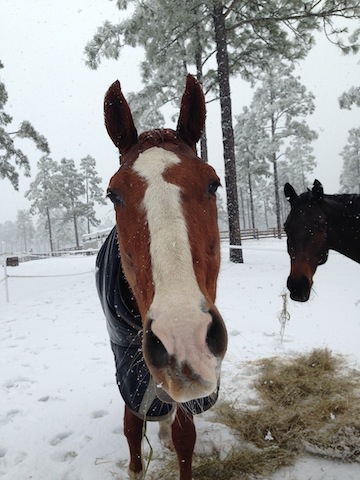In a cartoon widely shared on Facebook, a horse wearing five blankets, but sweating in his cold-weather gear, explains his multiple layers to another horse in the paddock: “My Mom was cold.”
Funny as the cartoon was during this nationwide cold snap, Dr. Ginger Reed, VMD, Rood & Riddle Equine Hospital, says most healthy horses are well equipped to endure cold temperatures without undo fuss.
And in this week’s Veterinary Answers, Dr. Reed discusses ways to ensure that the horses are happy during this seemingly endless winter, and offers tips for feeding, clothing and keeping a horse during the winter months.
Q: What guidelines would you recommend for blanketing horses in frigid temperatures?
I have a Quarter Horse, and he has one turnout blanket and he’s outside 18 hours a day.
Horses really do very well in a constant climate, as long as they’re given time to acclimate to their climate. Horses who live in Michigan know it and they get ready for it, and horses who live in Florida also get ready for their climate.
In general, it takes about two or three weeks to adapt to a climate change, so if you have a Thoroughbred racehorse moving from Florida to Kentucky, I would recommend blanketing for a few weeks.
Auburn University recently released a helpful flow chart on equine winter care, and it’s very helpful. With temperature and blankets, it basically states that if it’s less than 50 degrees, let’s think about other factors that contribute to a horse’s comfort. For example, what’s the wind chill? Is the horse new to the climate? Has the horse moved and is there a 40-degree difference? Does the horse have a full coat, or has he been clipped? Is precipitation in the forecast? If it’s 45 degrees and raining, that makes a big difference, because any time there’s precipitation, it lowers their ability to fight off cold. And the wind also severely impacts their ability to keep warm.
One of the biggest things to consider is whether your horse is either very young or old, because they don’t have the same abilities of an average age horse in good health. Sick horses, or horses who have had a recent bout of illness, or a high parasite load, also require more care.
Q: What is your opinion on layering blankets?

Metro, the famous painting horse, takes his owner Ron Krajewski up on the triple-dog-dare to stick his tongue to the fence. Wearing one blanket, he is riding out the rough winter with no problem.
If you’re going to add blankets, it’s best to do it gradually, as the temperatures drop.
But make sure the horse isn’t getting damp under there. Put your hand beneath, and feel. If the horse is wet, there’s too many blankets, and when you remove the blanket of a sweaty horse you risk shocking him with the cold.
Q: Do Thoroughbreds respond to cold differently than other breeds? If so, what is the reason?
You’re average 8-year-old Thoroughbred that’s healthy is the same as other breeds. Although horses with larger bodies, like Draft horses, tend do better in harsher climates. Icelandic ponies, for example, do really well in the cold.
The reason is they have a smaller body surface compared to their weight; they have this tank of a body. And the surface is where you lose heat across.
In Central Kentucky, horses are kept out during the day, and some farms keep them in at night. They do a build a nice coat, even the Thoroughbreds.
Track horses and show horses, on the other hand, have thin coats because they’re clipped. They should be coated, so they don’t run into problems, and newborn foals and younger horses, which are the opposite of the (hearty) draft horses, also have a lot of body surface and little weight, so they’re extra sensitive.
The thinner breeds and late-term pregnant mares are another group that we’re more cautious with. They have less energy to expend to keep them warm, so those girls stay in at night.

Allie Conrad of CANTER Mid Atlantic keeps the engines running in her horses with good hay. Photo by Allie Conrad
Q: What dietary tips would you recommend for keep a horse comfortable in the deep freeze?
The most important thing is water. Making sure they have fresh, non-frozen water is vital for their survival. Some horses are picky and won’t drink icy cold water, so for them, the water should be warmed. I have a heated water bucket in my own stall, and it’s a lifesaver!
The second critical element is feeding. People want to give their horses a warm bran mash in the winter, and it’s a nice way to get them extra water, because there’s so much in it.
But the most important thing is forage—hay. Horses have physiologic need for it. They’re hindgut fermenters, and that in itself is a natural heat source. They ferment the hay into heat, not the grain.
People burn more calories shivering than we do sweating. The same is true for the horse.
I have a horse that comes in at night, has hay, and is extremely picky, and on cold nights, every scrap of hay is gone by morning. But during milder temperatures, he doesn’t finish it.
Q: What are the most common horse-health issues that tend to arise in extreme cold? And how can an owner safeguard against it?
The first, which I’ve already touched on, is dehydration. If a horse isn’t getting enough water, the first thing you might see is a colicky horse. And they may become impacted because they’re not drinking enough.
If you see you’re adding less water to the buckets, think about why.
Another issue is frostbite. It’s not something we usually think about in horses, and it’s uncommon in a healthy horse, who has acclimated, and has protection.
But it is something to keep eye out for, and the most common spot is the tip of the ears.
A horse’s body naturally shunts blood away from their extremities to keep their core warm, and in the process, their ears can be vulnerable. A sign of frostbite is that the tips change color, becoming pale, black or red.

Lucy (Jockey Club: Iwanbegeorgiesgal), owned by Kate Taylor of Rhode Island, has a grand time this winter.
The best thing to do is contact vet. You don’t want to rub the site or try to heat the ears; the site needs to be properly warmed up by a vet in a way that doesn’t cause damage.
Another thing to think about are horses with secondary disease processes. If you have an older horse who has been outside, he could be more susceptible to respiratory disease, just like people who get really cold, and get sick.
Babies and older horses also need to be watched more closely, and if you suddenly change their environment, it’s important to consider that they’re more susceptible. So if you bring in horses who usually live outside, make sure their shelter is adequately ventilated, and clean, so there’s a good flow of fresh air.
Q: Is it ever advisable to try to heat a barn?
Most barns, after you close the doors, maintain an adequate air temperature. If there’s not too much ventilation, the heat from the horses naturally heats up a barn.
At the hospital we have temperature controlled stalls for foaling, or for sick animals. In your average horse-owner’s barn, you shouldn’t have those cases.



Bran Mash
1/2 of my horses grain ration
the other half wheat bran
Warm water
2 cups sugar free apple sauce.
mix grain, bran, water and then swirl in apple sauce.
Lisa or others,
Can you share your recipes for that mash? I am looking for good recipes for my older thoroughbred mares -thank you!
Our 3 OTTB’s love winter here in Maine! We’ve only blanketed them when we’ve had those sub-zero wind chill days and rainy/icy precipitation. They’ve all adapted well to being outside without blankets. We add a beet pulp/flax seed/ rice bran mash to the menu for winter. It helps keep them hydrated and they like it more than their grain. They all watch me make it, heads peering out their stall doors, ears pricked, as if to ask, “Is it ready yet?”
First pic I saw of my boy on CanterPA was him, sans blanket with a woolly coat. The first few winters here in MA he was in a low ceiling barn of 20 stalls. All of which were full. Then I moved him to a place that his stall is part of a two stall shed row. And he began shivering when it hit 40 degrees. So he has been blanketed since our first winter there. I rough board, so every morning I make him soaked timothy/alfalfa cubes. With some black strap molasses added, since it has all the electrolytes that the powdered stuff has. And he likes the taste better.
I also cut his grain back because he isn’t getting as much exercise or turnout this winter.
When it’s really hot out I do the same. But soak the cubes in cold water, not hot. Just to make sure he’s getting water.
Dr. Reed question about our reacent extreme temps in Duluth MN. Much discussion at barn, I only blanket in cold icy rain at the 30 degree range. The 40 below windchill we kept them inside for all but an hour. It is the 10 to 10 below temps… what is recommended? All are well warm bloods, ottb, and Arabs 4 to 19 years worked 2 to 6 times a week depending on owner. (Light walking work when very cold less than 0.) Some clients want blankets all the time and horse sweats which I think worse. What is your opinion?
Did see recent article in Eventing Nation. Gets here up to owners.